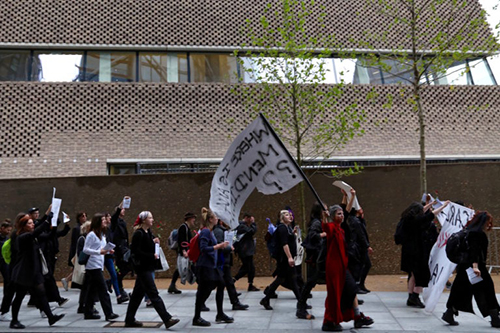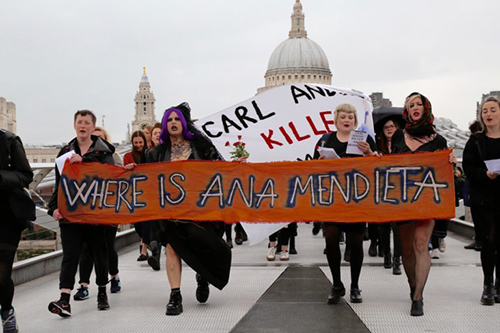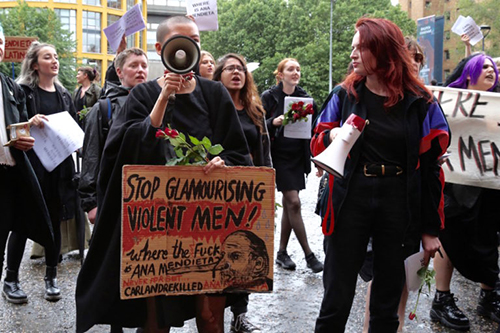LONDON — Posters all around London advertising Tate Modern’s new building proudly proclaim: “Art Changes. We Change.” For the protestors who gathered outside the artists’ preview of the extension last night, too little has changed. Members of the activist groups WHEREISANAMENDIETA and Sisters Uncut were on hand to protest the inclusion of Minimalist Carl Andre’s work in the museum’s extension, and the exclusion of Ana Mendieta’s work.
Clad in black and clutching roses as if for a funeral, protesters gathered on the steps of St Paul’s Cathedral before walking across Millennium Bridge to Tate Modern. Three slogans were chanted continuously: “OI TATE, WE’VE GOT A VENDETTA – WHERE THE FUCK IS ANA MENDIETA?”, “ANDRE, ANDRE, ANDRE, WHAT YOU GONNA DO, WHAT YOU GONNA DO WHEN WE COME FOR YOU?”, and, chillingly, “I WAS PUSHED — I DID NOT FALL.” Attending as both a supporter and a journalist, I joined the crowd. We formed a line across the entrance to Tate’s Turbine Hall before slipping under the cordons and rushing to the cavernous space’s glass doors. We shouted and pressed our banners and signs against the windows, disrupting the soirée (which Andre was expected to attend). Tate staff stared back blankly through the glass as well-groomed attendees variously gawped, feigned indifference, or quietly signaled support. The protesters then moved from the Turbine Hall entrance to the staff entrance at the rear of Tate, where they continued to chant despite police attempts to intervene. The protest ended peacefully, with participants sharing poems and thoughts on the themes of Mendieta’s art, violence, and cultural erasure.
Protestors form a line preventing access to Tate Modern’s Turbine Hall
This was one of many impassioned expressions of dissent that have taken place since Mendieta’s death in 1985, at age 36. (She died after falling from the window of the 34th floor apartment she shared with Andre, her husband of eight months; he was acquitted after a highly controversial murder trial.) Tate owns five of Mendieta’s works and 10 of Andre’s. None of Mendieta’s are on display in the new building — a curious omission in an institution currently broadcasting its increasingly inclusive curation.
“It’s to do with canonization,” said a fine art tutor from Goldsmiths who witnessed the protest but wished to remain anonymous. “The Tate is art history. What’s potentially troubling is that Carl Andre’s in the new wing of Tate Modern; it serves to entrench what’s already been established.” Most passersby, however, seemed to have no idea who either Andre or Mendieta were, though they were curious about this voluble, unruly gathering.
“Quite a few people didn’t know who he or she was — it’s all so long ago,” Jan, another preview attendee, said. “Some thought the protest wasn’t real or that it was performance art, but Anish Kapoor told us it was real. I think it’s terrible that he killed her and walked away, though I don’t know why they’re bringing it up now. But I don’t think anyone’s particularly upset about the disruption.”
Chanting slogans on the Turbine Hall ramp outside the artist’s preview
“This has happened over and over again, whenever you show Carl Andre,” said outgoing Tate Modern Director Chris Dercon. “We have a reenactment of the protest against the Dia Art Foundation being performed in the Tanks — the protesters just don’t know it! Romanian artists Alexandra Pirici and Manuel Pelmus are currently re-enacting the actions outside the Andre exhibition at Dia, which they think is very important. Besides, we have two works by Ana which are also being re-performed. Somebody needs to tell the protesters — that’s why I’m standing here!” An exhaustive exploration of Tate’s website yielded no evidence of the restaged protest, while no press or information officers could tell me anything about either the Mendieta or the Pirici and Pelmus performances.
In response to the news of Pirici and Pelmus’ performance, the organizers asserted that to re-enact protest within an institution is to sanitize it — to safely relegate something visceral and vital to the archive. “By showing Carl’s work while also claiming to support Ana, Tate are not making a decision,” said protesters Bronte Dow and Hannah Regel. “Even showing the re-performance of the Dia protest collaborates in Tate’s erasure of this injustice. They’re avoiding confrontation.”
Both Mendieta’s art and her story invite identification. Her posthumous narrative has been a potent blend: growing recognition of her artistic achievements alongside apparent erasure, exclusion, and, in the words of the protest’s organizers, the institutional primacy of “a violent white man over a dead woman of color. This is a rhetoric we encounter constantly, daily, and it must end.”
 Protesters chanting slogans on the Turbine Hall ramp outside the artist’s preview
Protesters chanting slogans on the Turbine Hall ramp outside the artist’s preview

Protesters pressing their signs and bodies against the windows of the Turbine Hall

Chanting slogans on the Turbine Hall ramp outside the artist’s preview

Chanting slogans on the Turbine Hall ramp outside the artist’s preview

Legal observers discuss the protest with the police

Protestors outside the new Herzog & De Meuron-designed Tate Modern extension








